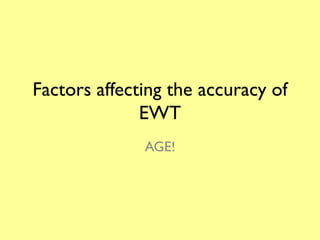Age
•
3 likes•1,876 views
1) Younger children and older adults perform worse on eyewitness testimony (EWT) than young or middle-aged adults due to difficulties with source monitoring. 2) A study found that younger children incorporated new information from a story into their accounts of an original science demonstration, showing an inability to distinguish the source of information (poor source monitoring). 3) In contrast, older children were able to remove the new information from their accounts, showing better source monitoring abilities than younger children. This suggests EWT is less reliable from young children and older adults.
Report
Share
Report
Share
Download to read offline

Recommended
Children’s Nature Deficit: What We Know - and Don’t Know
`
For more information, Please see websites below:
`
Organic Edible Schoolyards & Gardening with Children =
http://scribd.com/doc/239851214 ~
`
Double Food Production from your School Garden with Organic Tech =
http://scribd.com/doc/239851079 ~
`
Free School Gardening Art Posters =
http://scribd.com/doc/239851159 ~
`
Increase Food Production with Companion Planting in your School Garden =
http://scribd.com/doc/239851159 ~
`
Healthy Foods Dramatically Improves Student Academic Success =
http://scribd.com/doc/239851348 ~
`
City Chickens for your Organic School Garden =
http://scribd.com/doc/239850440 ~
`
Simple Square Foot Gardening for Schools - Teacher Guide =
http://scribd.com/doc/239851110 ~Children’s Nature Deficit: What We Know - and Don’t Know

Children’s Nature Deficit: What We Know - and Don’t KnowSchool Vegetable Gardening - Victory Gardens
More Related Content
Similar to Age
Children’s Nature Deficit: What We Know - and Don’t Know
`
For more information, Please see websites below:
`
Organic Edible Schoolyards & Gardening with Children =
http://scribd.com/doc/239851214 ~
`
Double Food Production from your School Garden with Organic Tech =
http://scribd.com/doc/239851079 ~
`
Free School Gardening Art Posters =
http://scribd.com/doc/239851159 ~
`
Increase Food Production with Companion Planting in your School Garden =
http://scribd.com/doc/239851159 ~
`
Healthy Foods Dramatically Improves Student Academic Success =
http://scribd.com/doc/239851348 ~
`
City Chickens for your Organic School Garden =
http://scribd.com/doc/239850440 ~
`
Simple Square Foot Gardening for Schools - Teacher Guide =
http://scribd.com/doc/239851110 ~Children’s Nature Deficit: What We Know - and Don’t Know

Children’s Nature Deficit: What We Know - and Don’t KnowSchool Vegetable Gardening - Victory Gardens
Similar to Age (20)
Contents lists available at ScienceDirectNeuroscience and 

Contents lists available at ScienceDirectNeuroscience and
Children’s Nature Deficit: What We Know - and Don’t Know

Children’s Nature Deficit: What We Know - and Don’t Know
GraduateStudentsAndMotivationChristinaSandersonRMFINAL

GraduateStudentsAndMotivationChristinaSandersonRMFINAL
More from sssfcpsychology
More from sssfcpsychology (20)
Age
- 1. Factors affecting the accuracy of EWT AGE!
- 2. Children are more willing than adults to …but they are often wrong make an Dekle et al (1996) identification… Children are It’s not just children… unreliable eyewitnesses Older people also because they are perform worse on EWT more susceptible to studies than young or the post-event middle-aged participants effect Old men - Which is? in particular
- 3. Age - research Poole & Lindsay (2001) AIM: - Source Monitoring To investigate the effect of age on the Source accuracy of EWT monitoring is whether or not someone can identify the origin of the information i.e. where they heard/saw it first
- 4. Age - research PROCEDURE: Children aged 3-8 – watched science demonstration Parents read children a story (which included some element of the science demonstration and some new information) Children questioned about original science demonstration, found they incorporated much of the new information from the parent’s story – children were asked to identify the origin of the information (this is called source monitoring) The researchers were interested in whether the children could source monitor and distinguish between information from the science demo and information from the story
- 5. Age - research FINDINGS: Older children revised their account of the science demonstration and removed the post-event information Younger children were not able to do this CONCLUSIONS: Because the young children weren’t able to distinguish where the information came from, it is concluded that children are poor at source monitoring It can be implied from this that older children are more likely to give more accurate accounts of events, whilst EWT from a young child is more likely to be less accurate and therefore less reliable
- 6. Age – research evaluation What type of experiment did What’s good about this? Poole and Lindsay conduct? What’s not so Who were the good participants? about Ethical considerations? this?
- 7. Age evaluation High ecological validity For example, it was conducted in a real life natural setting This a strength because the findings can be This means that generalised beyond the researchers the research were investigating real life behaviour setting and applied to real life EWT
- 8. Age evaluation Ethical Issues For example, the participants were children and therefore unable to give fully informed consent This a strength because This means that researchers had the parents of parents actively the children involved and involved were required to give consent was consent gathered
- 9. Age evaluation Low control For example, variables such as light, time of day etc were not controlled This a weakness because it suggests that This means that researchers cannot the research has establish cause and low internal validity effect between the IV and the DV